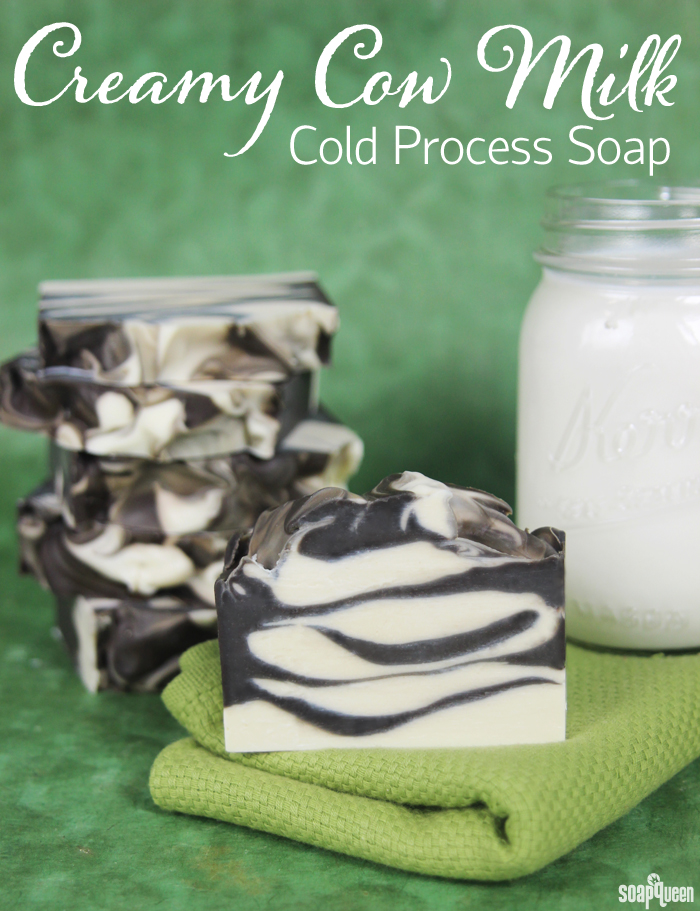
Soap made with goat milk is popular, but did you know luxurious soap can also be made with cow milk? For this Creamy Cow Milk Cold Process Tutorial, whole cow milk is used to add extra moisture and skin-loving properties. Full of contrast, this project features black and white layers reminiscent of a cow pattern. The scent combination of Vanilla Rosewood and Grass Stain fragrance oils creates a blend that is both warm and green…similar to a barn!
Freezing the cow milk before adding the lye prevents the milk from scorching. For a step by step tutorial of this process, check out this How to Add Lye to Milk for Cold Process Soap blog post. When selecting milk for soap making, be on the lookout for the least amount of additives such as vitamins, preservatives or thickeners. These additives can cause unpredictable soaping results. It can be difficult to find milk without vitamins. This recipe uses whole milk with added vitamin D; it worked great. You can also use skim, 1% or 2% milk if you’d like.
What You’ll Need:
10″ Silicone Loaf Mold
3.5 oz. Sweet Almond Oil (10%)
8.8 oz. Coconut Oil (25%)
10.5 oz. Olive Oil (30%)
8.7 oz. Palm Oil (25%)
3.5 oz. Shea Butter (10%)
4.9 oz. Sodium Hydroxide Lye
11.6 oz. Whole Milk
1 oz. Vanilla Rosewood Fragrance Oil
1 oz. Grass Stain Fragrance Oil
Titanium Dioxide Pigment
Activated Charcoal
 Click here to add everything you need for this project to your Bramble Berry shopping cart!
Click here to add everything you need for this project to your Bramble Berry shopping cart!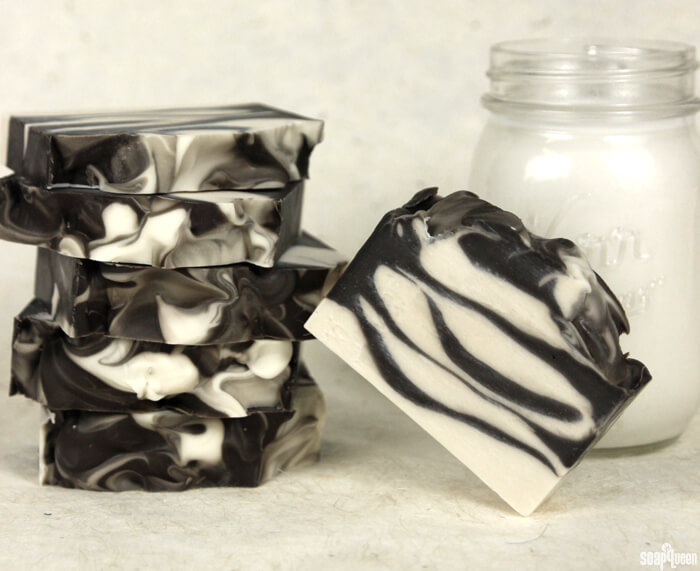
If you’ve never made Cold Process soap before, stop here! I highly recommend checking out our FREE four part SoapQueen.tv series on Cold Process Soapmaking, especially the episode on lye safety. And if you’d rather do some reading, Bramble Berry carries a wide range of books on the topic, including my newest book, Soap Crafting. You can also checkout the digital downloads for that instant gratification factor.
SAFETY FIRST: Suit up for safe handling practices! That means goggles, gloves and long sleeves. Make sure kids, pets, and other distractions and tripping hazards are out of the house or don’t have access to your soaping space. Always soap in a well-ventilated area.
MILK PREP: Measure out 11.6 ounces of whole milk. Pour the milk into ice cube trays and place them into the freezer until completely hard (several hours to overnight).
COLOR PREP: To ensure that the Titanium Dioxide blends smoothly into the soap batter, we recommend micronizing it before dispersing it in oil. Please note this is an optional tip but it does help with the titanium dioxide clumping in the soap =) To micronize colorant, simply use a coffee grinder to blend the colorant to break up any clumps of color and prevent streaks of white from showing in the final soap. We like to use a coffee grinder that has a removable, stainless steel mixing area for easy cleaning. Then, disperse 2 teaspoons of the colorant into 2 tablespoon of sunflower or sweet almond oil (or any other liquid oil). Disperse 2 teaspoons of the activated charcoal into 2 tablespoon light liquid oil. Use a mini mixer to get the clumps of color worked out smoothly.
ONE: Remove the fully frozen milk from the ice cube trays and put it into a container that has been placed in an ice bath. Slowly add lye and stir until the lye is fully dissolved and the milk has become liquid. Click here to see this process and more tips on creating a lye and milk mixture. If you’d like a harder bar of soap that releases faster from the mold, you can add sodium lactate to the cooled lye milk. Use 1 teaspoon of sodium lactate per pound of oils in the recipe. For this recipe, you’d add about 2.5 tsp. sodium lactate.
TWO: Melt and combine the coconut oil, olive oil, shea butter, sweet almond oil and palm oils (remember to fully melt then mix your entire container of palm oil before portioning). Once the oils have cooled to 130 degrees or below, add the lye milk to the oils and stick blend until thin trace.
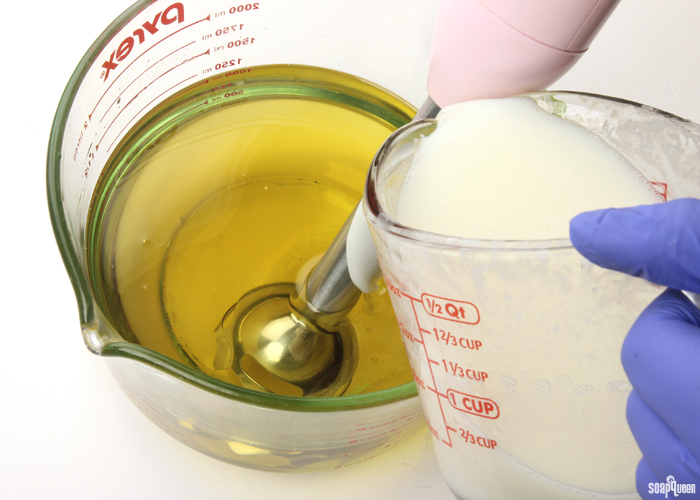
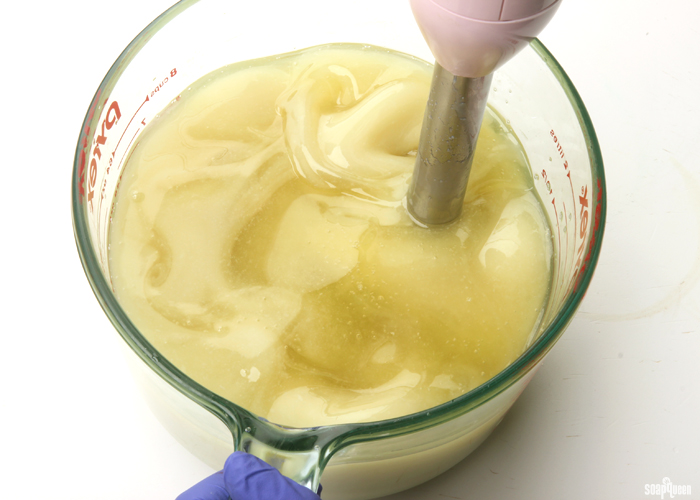 THREE: Once the batter has reached a light trace, split it evenly into two containers. Each container will hold about 3 cups. To one container, add all of the dispersed titanium dioxide. Use a whisk to fully blend in.
THREE: Once the batter has reached a light trace, split it evenly into two containers. Each container will hold about 3 cups. To one container, add all of the dispersed titanium dioxide. Use a whisk to fully blend in.
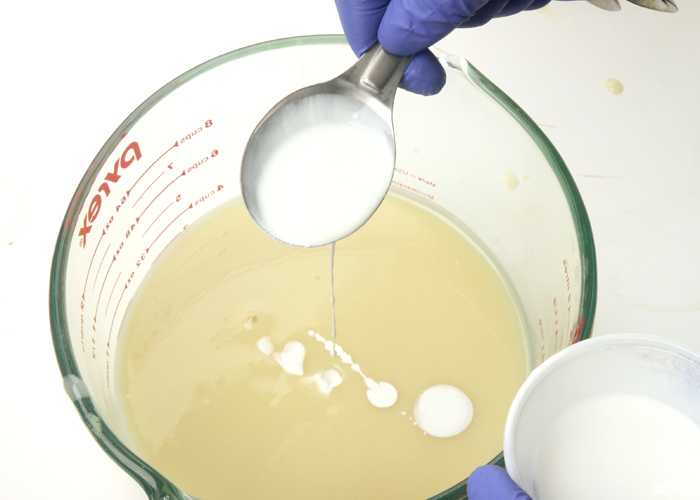 FOUR: To the other container, add 1 tablespoon and 2 teaspoons of the dispersed activated charcoal and use a whisk to fully mix in. To the black soap, add the Vanilla Rosewood Fragrance Oil. To the white soap, add the Grass Stain Fragrance Oil and use a whisk to mix in. Because the Vanilla Rosewood discolors to a deep brown, be sure not to mix the fragrances up! You can read more about fragrance discoloration in the Why Did My Soap Turn Brown post.
FOUR: To the other container, add 1 tablespoon and 2 teaspoons of the dispersed activated charcoal and use a whisk to fully mix in. To the black soap, add the Vanilla Rosewood Fragrance Oil. To the white soap, add the Grass Stain Fragrance Oil and use a whisk to mix in. Because the Vanilla Rosewood discolors to a deep brown, be sure not to mix the fragrances up! You can read more about fragrance discoloration in the Why Did My Soap Turn Brown post.
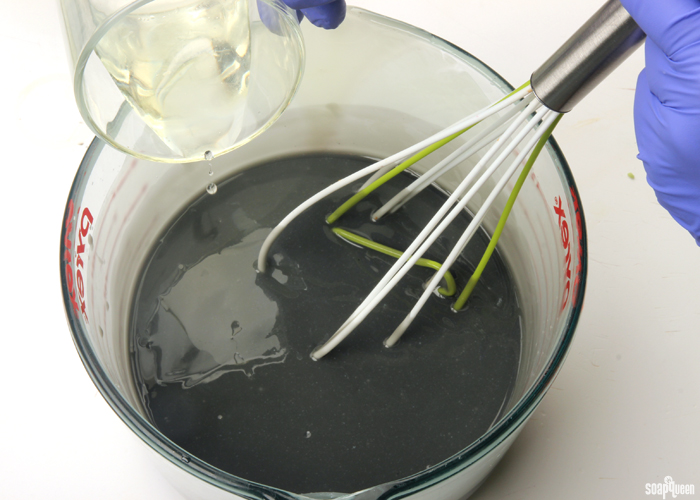 FIVE: The spoon-plop technique works best with a thick trace. To thicken the soap, stick blend each color for several seconds if necessary. The soap should be the texture of pudding.
FIVE: The spoon-plop technique works best with a thick trace. To thicken the soap, stick blend each color for several seconds if necessary. The soap should be the texture of pudding.
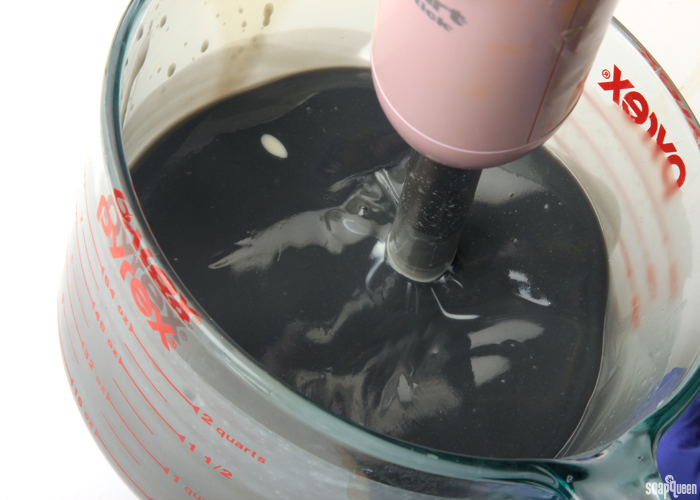 SIX: Grab a large spoon for each color. Spoon the soap into the mold, one color at a time, layering them in three different spots within the mold.
SIX: Grab a large spoon for each color. Spoon the soap into the mold, one color at a time, layering them in three different spots within the mold.
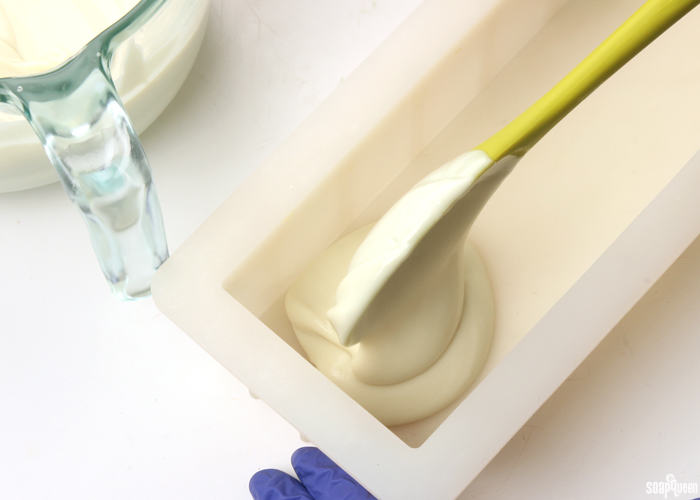
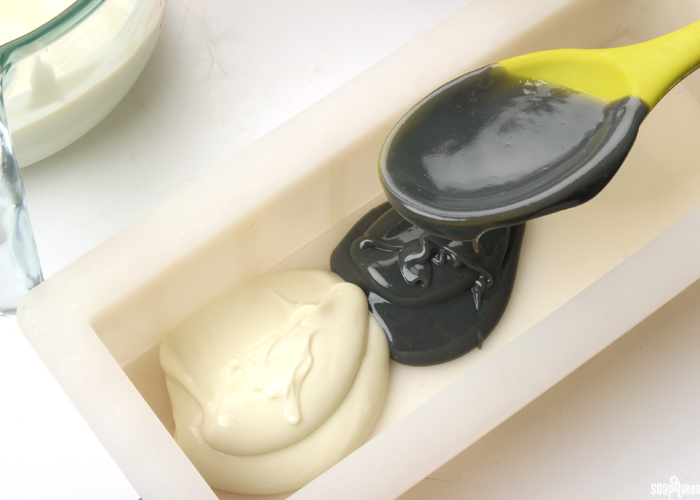 SEVEN: Continue to plop the soap, placing the white soap onto black and vice versa. Use some large plops and some small to add visual interest.
SEVEN: Continue to plop the soap, placing the white soap onto black and vice versa. Use some large plops and some small to add visual interest.
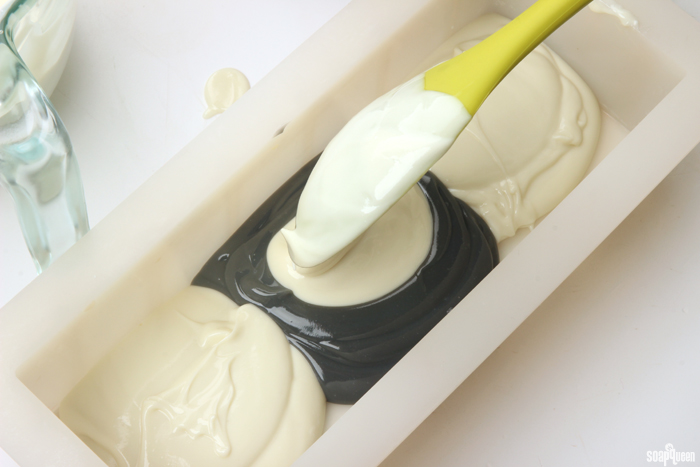
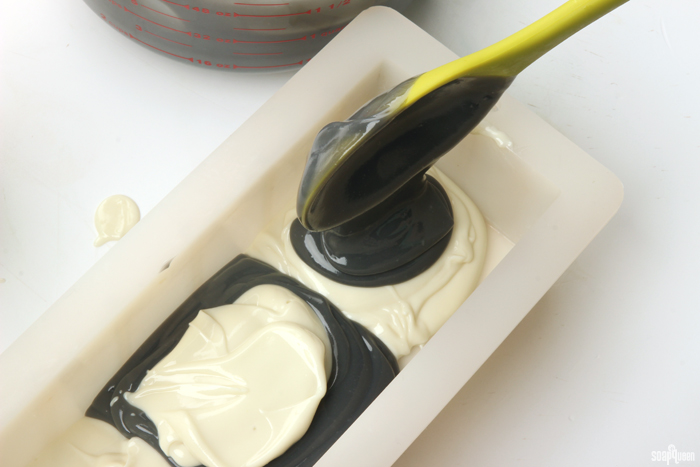 EIGHT: Keep layering the colors until the mold is completely full. Tap the mold firmly on the counter to help release any air bubbles.
EIGHT: Keep layering the colors until the mold is completely full. Tap the mold firmly on the counter to help release any air bubbles.
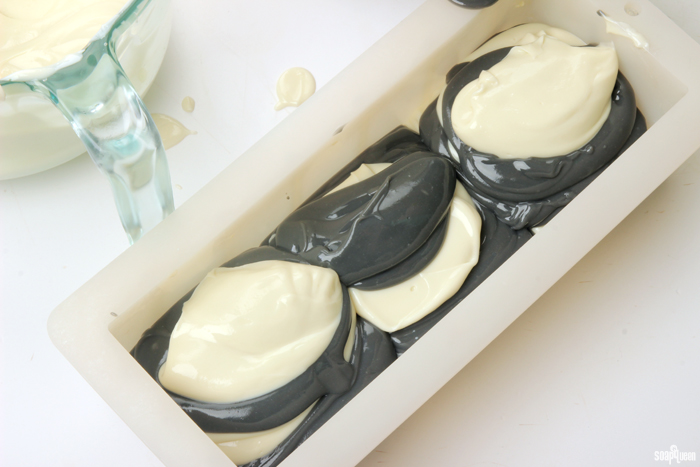 NINE: Use a spoon to mound the soap toward the center. Then, twist and turn the soap in the soap to create texture. Be careful not to play with the soap too much, or the colors will blend together into a light grey tone. Spray the top of the soap with 99% isopropyl alcohol and place the soap in the freezer for 5-24 hours to help prevent gel phase. Remove the soap from the freezer and allow to sit in the mold for 4-5 days. Milk soap can be a little softer due to the extra milk fat. Patience is key =) Once cut, the black soap will deepen in color over time due to the vanilla content in the Vanilla Rosewood Fragrance Oil.
NINE: Use a spoon to mound the soap toward the center. Then, twist and turn the soap in the soap to create texture. Be careful not to play with the soap too much, or the colors will blend together into a light grey tone. Spray the top of the soap with 99% isopropyl alcohol and place the soap in the freezer for 5-24 hours to help prevent gel phase. Remove the soap from the freezer and allow to sit in the mold for 4-5 days. Milk soap can be a little softer due to the extra milk fat. Patience is key =) Once cut, the black soap will deepen in color over time due to the vanilla content in the Vanilla Rosewood Fragrance Oil.
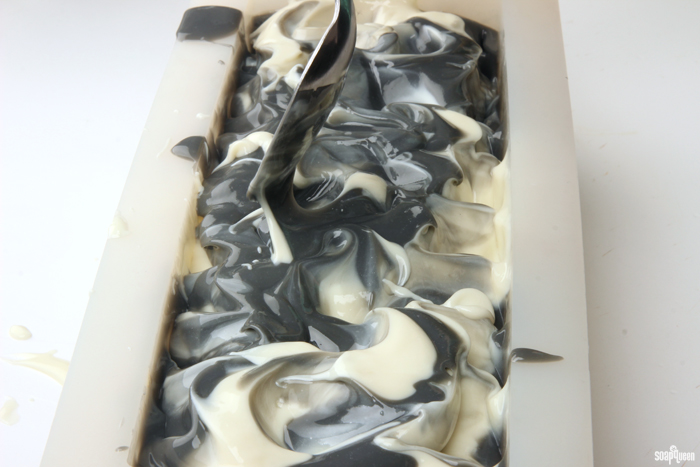
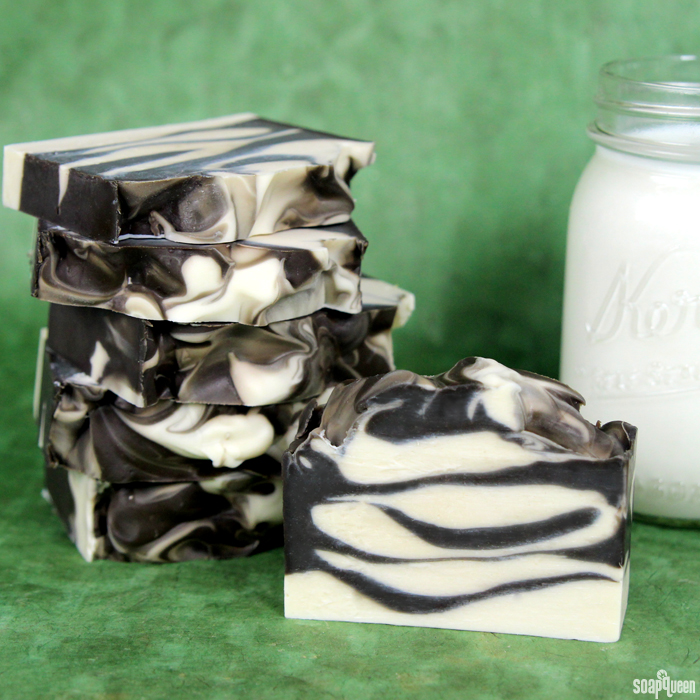
Have you ever used cow milk in soap before? I’d love to hear what you thought!
- 10" Silicone Loaf Mold
- 3.5 oz. Sweet Almond Oil (10%)
- 8.8 oz. Coconut Oil (25%)
- 10.5 oz. Olive Oil (30%)
- 8.7 oz. Palm Oil (25%)
- 3.5 oz. Shea Butter (10%)
- 4.9 oz. Sodium Hydroxide Lye
- 11.6 oz. Whole Milk
- 1 oz. Vanilla Rosewood Fragrance Oil
- 1 oz. Grass Stain Fragrance Oil
- Titanium Dioxide Pigment
- Activated Charcoal
- Remove the fully frozen milk from the ice cube trays and place into a container that has been placed in an ice bath. Slowly add lye and stir until the lye is fully dissolved and the milk has become liquid. Click here to see this process and more tips on creating a lye and milk mixture. If you’d like a harder bar of soap that releases faster from the mold, you can add sodium lactate to the cooled lye milk. Use 1 teaspoon of sodium lactate per pound of oils in the recipe. For this recipe, you’d add about 2.5 tsp. sodium lactate.
- Melt and combine the coconut oil, olive oil, shea butter, sweet almond oil and palm oils (remember to fully melt then mix your entire container of palm oil before portioning). Once the oils have cooled to 130 degrees or below, add the lye milk to the oils and stick blend until thin trace.
- Once the batter has reached a light trace, split the batch evenly into two containers. Each container will hold about 3 cups. To one container, add all of the dispersed titanium dioxide. Use a whisk to fully blend in.
- To the other container, add 1 tablespoon and 2 teaspoons of the activated charcoal and use a whisk to fully mix in. To the black soap, add the Vanilla Rosewood Fragrance Oil. To the white soap, add the Grass Stain Fragrance Oil and use a whisk to mix in. Because the Vanilla Rosewood discolors to a deep brown, be sure not to mix the fragrances up! =)
- The spoon-plop technique works best with a thick trace. To thicken the soap, stick blend each color for several seconds if necessary.
- Grab a large spoon for each color. Spoon the soap into the mold, one color at a time, layering them in three different spots within the mold.
- Continue to plop the soap, placing the white soap onto black and vice versa. Use some large plops and some small to add visual interest.
- Keep layering the colors until the mold is completely full. Tap the mold firmly on the counter to help release any air bubbles.
- Use a spoon to mound the soap towards the center. Then, twist and turn the soap in the soap to create texture. Be careful not to play with the soap too much, or the colors will blend together into a grey tone. Spray the top of the soap with 99% isopropyl alcohol and place the soap in the freezer for 5-24 hours to help prevent gel phase. Remove the soap from the freezer and allow to sit in the mold for 4-5 days. Milk soap can be a little softer due to the extra milk fat. Patience is key =)


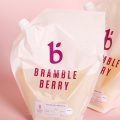
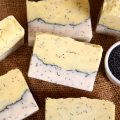

Could you possibly offer this recipe with percentages as opposed to measurements in ounces? I’d like to give it a tey, but have a 6 lb. mold!
Thanks!!
I added percentages to the blog post! I found those with our Lye Calculator. All you have to do is plug in the oil amounts and hit calculate – it will give you the percentages of each. 🙂
Lye Calculator: https://www.brambleberry.com/Pages/Lye-Calculator.aspx
-Kelsey with Bramble Berry
Thank you!!
Hi 🙂 I’ve made milk soap from cows milk and it turned out pretty well. However, it’s going kind of brown when I use it in the shower. Why is it doing that? How can I stop it discoloring?
Thanks, Roberta
Did you use a fragrance with vanilla in it, or one that discolors? If so, that may be turning your bars brown. Let me know! 🙂
-Kelsey with Bramble Berry
I tried this recipe with cow’s milk and activated charcoal I got from brambleberry. I love the feel of soap but, I feel like the black color (charcoal) is bleeding through the soap. I tested soap after 4.5 weeks. Should I cure it more? Or could it be because some mistake while making soap?
If too much charcoal is used, it can lather gray or black. That is fairly common with activated charcoal! Because this soap is black, it does lather slightly gray. If you’re not a fan of that, you can add less charcoal. Your soap will be more gray than black, but it is less likely to bleed. 🙂
Learn more about charcoal here: https://www.soapqueen.com/bath-and-body-tutorials/tips-and-tricks/activated-charcoal-skin-benefits-tips-for-use/
-Kelsey with Bramble Berry
Hi.. I’m really interested in trying this recipe out. However, I only have a home-made wooden mold at home that fits 4lbs of soap. I really couldn’t afford to add the 10′ silicone mold, so I’m wondering how I can recalculate this and any other recipe to fit a specific mold. Can you please help me figure this out? Thank you!
We have a really helpful posts that shows you how to resize recipes using the Lye Calculator! You can find that here: https://www.soapqueen.com/bath-and-body-tutorials/tips-and-tricks/how-to-resize-cold-process-soap-recipes/
That post was written when we had our old Lye Calculator, so it does look a bit different. However, it still works the same as the screenshots shown. 🙂
Lye Calculator: http://www.brambleberry.com/Pages/Lye-Calculator.aspx
-Kelsey with Bramble Berry
HI! I’ve got a question for you guys. I’m still fairly new to making soap. I began about 5-6 months ago. I’ve made quite a few batches and they’ve all turned out great and even my skills have improved (bars, cuts and design are looking better and better!) I have really been wanting to make soaps using milk for a while now. Recently I was given several half gallons of buttermilk and a half gallon of goat’s milk. All were close to expiration and my family I won’t drink these milks, but I didn’t want them to go bad either so I froze them. Anyway, I am wondering, are you supposed to measure the amount of milk needed for a recipe first then freeze, or can I get an accurate weight if it’s already frozen and I measure it out in cubes? Does this matter?
You can measure it either way! I like to measure out how much milk I’ll need beforehand plus a little extra. Then, measure those cubes again when they’re frozen. That way if any milk gets stuck to the sides of the ice cube tray, you can add your extra. Measuring twice is always good when it comes to soaping! You can also freeze all of your milk into cubes, then measure out for your batches as needed. 🙂
-Kelsey with Bramble Berry
Thanks for the suggestion and for such a speedy reply! This is going to be my next project, but I’ll be using the goat’s 🐐 milk I have in place of cow’s 🐮 milk. I would love to see more milk related recipes!
You’re welcome! We love how creamy milk soap feels, so we’ll definitely have more recipes with it in the future. 🙂
-Kelsey with Bramble Berry
I used your recipe and changed it a little. After running through lye calculator it says I need a certain amount of water. I am thinking that I need to discount the water or deduct the amount of yogurt I am using from the water amount to make up for the water in the yogurt. My question is should I do a water discount instead since the yogurt has less water than the milk? I plan on doing a 5% instead of 6% lye discount. Thank you :0)
I would recommend subtracting the yogurt amount from the main water amount! That will account for any extra water in the yogurt. It will also help it harden a bit faster, as you won’t have water and the added fat from the yogurt. Instead, you’ll have a lower water amount if that makes sense! 🙂
-Kelsey with Bramble Berry
I understand perfectly. Thank you! :0)
You’re welcome! 🙂
Help! I’ve been making cold process milk soap for a year now and here lately my soap has been coming to a really awful thick trace super fast. One minute it looks great and is barely at trace and then BAM! it’s thicker than a cow patty. I’ve been doing everything the exact same way since I started, so I don’t understand what I’m doing wrong. My milk is in ice cubes, I put the bowl in an ice bath while adding the lye, and I’m careful to add it slowly. My lye mixture ends up being around 75-78 degrees by the time I’m done. Do you have any ideas for me?
Hmm, I’m wondering if it may be false trace. Are you using any butters or hard oils in your batch? When cold lye is added to a recipe with hard oils, it can start to resolidify them. This is called “false trace” and you can read more about it here: https://www.soapqueen.com/bath-and-body-tutorials/tips-and-tricks/spot-prevent-false-trace/
If that is the case, you can let the lye sit at room temperature for a bit after it’s incorporated! That will help warm it up slightly. Around 80-85F should be good. That way it shouldn’t solidify the hard oils, but will still be cool enough not to scorch. 🙂
-Kelsey with Bramble Berry
Hi, I love the milksoap. I love tour method too (put in the freezer ) the color is more light and white, so, I have to learn more on this saponification in the fridge or freezer. Do you have somes books or somes links who give some explication of this? Thank you so much!
Hi Gisele!
We sure do! Warm temperatures can scorch the milk, which makes it discolor. You can read more about that in this post: http://www.soapqueen.com/bath-and-body-tutorials/tips-and-tricks/how-to-add-lye-to-milk-for-cold-process-soap/
This video talks more about it as well: https://www.youtube.com/watch?v=D8-D7nGlwFk
We also have a book on making milk soap you may like! I’ll link that below. 🙂
Making Milk Soap From Scratch E-Book: https://www.brambleberry.com/E-Book-Making-Milk-Soap-from-Scratch-P5257.aspx
-Kelsey with Bramble Berry
Thank you. Are you Telling me that you are the only personne who made milksoap like this? Do you create this technic by yourself?
I’m impressed, wow. You are my idole !!!! Congratulation .
Milk is a really popular ingredient for soap! People often use it to add creaminess to the bar. We learned how to work with it through a bit of trial and error. 🙂
-Kelsey with Bramble berry
The more i read, the more confusing it gets. I’ve been using brambleberry’s calculator for my recipes and the water measuring is in grams, although in the older posts on here the water is in volume.
Could you please clear this out for me? Should i measure water in volume or in weight, should i just follow the calculator?
Is quite a difference between volume and weight and i am not sure how to continue with the soap making.
Thank you so much in advance.
Hi Helen!
I’m sorry for the confusion! We recommend measuring the ingredients in this recipe by weight. We have tried both ways and found weight is a bit more accurate. Also, our Lye Calculator does have a section for ounces. That may a bit easier to measure out on a scale. 🙂
Read more about weight vs. volume here: http://www.soapqueen.com/bath-and-body-tutorials/tips-and-tricks/a-guide-to-weight-vs-volume/
-Kelsey with Bramble Berry
Is there a way to work around freezing it. My mold will not fit in my freezer.
Hi there!
If that soap is a bit too big for your freezer, you can put it in the refrigerator! That should help keep it cool. You can also place it in a cool room, like a basement. Another option is a cooler with ice or ice packs. Any cool environment will help prevent the soap from getting too hot and scorching the milk. 🙂
-Kelsey with Bramble Berry
We have a Jersey cow,,rich creamy milk. How would using her milk change the recipes.
Hi Elaine!
You can use the Jersey cow milk in your recipe! It will give the soap a rich and creamy feeling. You can use any milk you like in soap – cow milk, goat milk, almond milk, etc. The different milk may feel a bit different in the soap, but they will all add a nice creamy feeling to the recipe. The key is to freeze the milk before adding the lye and keep the soap cool afterward to prevent scorching. 🙂
Learn more about working with milk here: http://www.soapqueen.com/bath-and-body-tutorials/tips-and-tricks/how-to-add-lye-to-milk-for-cold-process-soap/
-Kelsey with Bramble Berry
I finally tried it and I think I’m hooked. I wasn’t able to use these colors because my goat’s milk was a very dark tan. It was well within the expiration date and it smelled fresh so I used and lightened it with titanium dioxide. Since it was more along the tan scheme, I darkened the other half with the pumpkin souffle fragrance oil. I froze it and slowly added the lie and kept the container in an ice bath. There was a SLIGHT ammonia smell but minimal. I layered it as described above, put it into the freezer two hours and the fridge over night. NOTE FOR NEXT TIME: leave it in the freezer. There is a slight gel phase ring (I didn’t cut it, but I had to cut one piece to see the middle!) but it is still overall a fantastic looking and smelling soap and it feels so smooth. I can’t wait to try it.
Suggestion: I can’t stand facebook and other social media, so could your software department create a way to post pictures here?
Thanks for the instructions here. I love my first attempt at milk soaping!
So glad the soap turned out well James! Also, thanks so much for your suggestion. I passed it along to our blog design team. 🙂
-Kelsey with Bramble Berry
Kelsey, I usually only have half and half or heavy cream in the house… Can I use either of those instead of regular milk? TY!
Hi Suzanne!
I believe that would be just fine! Because they have a higher fat content than milk, I would recommend lowering the superfat to 3-4% to ensure the bars aren’t too soft. You may also make a small test batch to see how it acts when the lye is added. Lye naturally reacts with the fats in the milk, and may get quite thick with cream or half and half. You can see the lye reacting with milk here: https://www.soapqueen.com/bath-and-body-tutorials/cold-process-soap/buttermilk-bastille-baby-bar-on-soap-queen-tv/
You can also add the cream at trace! That’s what we did for the Strawberries and Cream Cold Process Recipe: https://www.soapqueen.com/bath-and-body-tutorials/cold-process-soap/strawberries-cream-soap-a-cold-process-tutorial/
-Kelsey with Bramble Berry
Hi. I’m very experienced at cold and hot process soaps from beginning to advanced and I’ve always been curious about using milk and I’m ready to try for the first time and I love this design. One question: I’ve watched several soapers recommend and use the freeze method to keep the milk creamy and white, but I just noticed that Anne Marie said to use volume vs weight to measure the milk. Why is that? This recipe calls for 35 oz total oils, but I’m going to use my tried and true recipe with 35 total oz oils. Of course, I will use a lye calculator, but measuring vs weighing the milk is my only concern.
Thanks for everything!!
Hi James!
In the past, we have measured milk by volume. However, after a bit more testing, we found that weight was a bit more accurate for us! So, all of our milk recipes now use weight measurements. 🙂
A Guide to Weight vs. Volume: http://www.soapqueen.com/bath-and-body-tutorials/tips-and-tricks/a-guide-to-weight-vs-volume/
Have fun making milk soap! It feels so nice and creamy on the skin. This post has some helpful tips for making it: http://www.soapqueen.com/bath-and-body-tutorials/tips-and-tricks/how-to-add-lye-to-milk-for-cold-process-soap/
-Kelsey with Bramble Berry
I have been wondering how I could prepare a cow milk soap and I fortunately chanced on this blog. I have a question. In my part of the world, skimmed powered milk is more easily accessible. In using this, one has to use water in dissolving it before adding the lye. Wouldn’t this drastically reduce the moisturising properties of the milk compared to using whole milk?
Hi Daniel!
We have used lots of different types of milk, including whole, powdered, skim, etc. We have found they all add a nice creamy feeling to the soap. The skim milk may be just a tad bit less moisturizing, but it will still feel amazing on the skin. 🙂
-Kelsey with Bramble Berry
Hi there!
I really really hope you can help me with this question!
There is something i have been wondering about for a while now and i can’t seem to find an answer anywhere; Does the soap turn/ go rancid faster because of the milk? Do you need to use it within a certain amount of time?
It would be a bit of a dissapointing gift if you open the wrapper and there is this sour smelling, fur growing, clump of something that once resembled soap XD
Thank you in advance!
Kind Regards,
Jiska
Hi Jiska!
I can definitely help you with that question!
When you add milk to a recipe, it is turned into soap. In the saponificaiton process, the milk will go through pH changes and the end result is soap. I like to think of it like baking cookies. You start out with sugar, flour, eggs, etc., but the end result is a cookie.
Because of this, the shelf life will be the same as soap made with water! The shelf life itself depends on the oils added. So, if you’re using oils with a shelf life of a year, the soap will last about a year. Soap made with a short shelf life oil, like hazelnut (3 months), will last about three months. Read more about oil shelf lives here: http://www.soapqueen.com/bath-and-body-tutorials/lotion/talk-it-out-tuesday-preservatives/
That being said, adding a lot of fresh ingredients to your soap can affect the shelf life. For instance, a soap made with milk instead of water will have a regular shelf life. However, if the soap has milk and other additives like fruits, it can shorten by a couple months. Our Strawberries and Cream Bars were made with cream and strawberry puree, so they had a shelf life of about 6 months: http://www.soapqueen.com/bath-and-body-tutorials/cold-process-soap/strawberries-cream-soap-a-cold-process-tutorial/
-Kelsey with Bramble Berry
Hello! I just made this (with Eucalyptus) and it already looks and smells amazing! I have a question though! If I were to make this as a face bar, what would be the recommended superfat Ya? I’m sure the charcoal and the milk would be awesome!! Thanks so much!
That’s awesome, glad that soap turned out well! I think this recipe would make a great facial bar. Because of the milk, it feels so soft and silky on the skin. 🙂
Right now it’s superfatted at 5%. What superfat level you choose is a bit of personal preference! If you have drier skin, a superfat of 5-7% would feel really nice and moisturizing on the skin. For oilier skin, you may want to superfat around 2-4%. That way, the bar is a bit more firm and cleansing.
The best way to find out is to test some on your face! Then, you can adjust the superfat level from there. 🙂
Read more about superfatting here: http://www.soapqueen.com/bath-and-body-tutorials/cold-process-soap/superfatting-soap-an-explanation-2/
-Kelsey with Bramble Berry
Dear Kelsey,
Thank you so much for your answer and explanation! I can now say that i feel comfortable adding milk to soap, and will do so in my next project.
Again, thank you so much for taking the time to answer my question!
Kind Regards,
Jiska
You’re very welcome Jiska! Have fun making creamy milk soap. 🙂
-Kelsey with Bramble Berry
this might sound silly but, is the milk measured by weight or volume? in anticipation of making this recipe, i froze just about 12 oz of milk, measured by volume…should i just weigh my cubes? or will it weigh more once frozen? feeling confused! thanks! 🙂
Hi Elizabeth!
The milk in this recipe is measured by weight. We like to measure the ingredients by weight because it’s a bit more accurate. You can read more about that here: http://www.soapqueen.com/bath-and-body-tutorials/tips-and-tricks/a-guide-to-weight-vs-volume/
I would recommend popping your milk on the scale to see if you have 12 ounces by weight. If not, you can freeze a couple extra cubes to get to 12 ounces. Have fun giving this recipe a try Elizabeth! It feels so nice and silky on the skin. 🙂
-Kelsey with Bramble Berry
Thanks so much Kelsey! Trying it today! 🙂
Have fun! Let us know how it goes. 🙂
-Kelsey with Bramble Berry
Thanks for such a beautiful recipe. Couldn’t have been more timely. I’ve always wanted to soap with cow milk as I’ve easier access to it than goat’s, but it seemed the entire soaping world would only use goat’s milk. Lol. I love the color pattern and this is definitely on my to-do-list.
Meanwhile I’m quite new at this soaping thing. I nearly gave up on cp due to ricing, utter seperation, seizing. Whew! You name it. Things took a turn for the better when I bought an infrared thermometer. Temperature made all the difference. I found a lot of troubleshooting help through reading wonderful blogs such as yours and others. I’ve been able to make some really luxurious bars friends and family can’t stop raving about.
Thanks again
You’re very welcome Toyin! We love the idea of using lots of different milks, and cow milk feels amazing on the skin. It’s so nice and creamy!
Also, I’m so glad you gave soaping a try again! I’ve had some soapy mishaps and I know it can be frustrating. Temperature is very important and that thermometer will be super helpful, especially when working with milk. Have fun making this creamy soap. 🙂
-Kelsey with Bramble Berry
Hi there!
I just made this soap, so far so good! I’m wondering though, why I should wait 4/5 days before taking it out of the silicone mold it? Is it because the bulk of the oils used are soft? I had made the Buttermilk Baby Bastille soap you guys have (turned out wonderful I might add, and OMG it smells awesome..) anyhoo, I made it and was able to remove from the silicone mold within 24 hrs of pouring it. (it was soft but firm, and was fine for cutting). Just wondering why this recipe is a bit different that way…
PS – LOL I’m very new to this world of soaping. 🙂
Annnd, I just read a recent post that apparently I’ve skipped right over that for the most part answers my question lolol. (Sorry)
No worries at all Kara! The Buttermilk Bastille Baby Bars actually have a water discount to help them harden and release faster. We have more on that here: http://www.soapqueen.com/bath-and-body-tutorials/tips-and-tricks/water-discounting-cold-process-soap-how-why/
If you have any more questions, don’t hesitate to ask. 🙂
-Kelsey with Bramble Berry
Buttermilk Bastille Baby Bars: http://www.soapqueen.com/bath-and-body-tutorials/cold-process-soap/buttermilk-bastille-baby-bar-on-soap-queen-tv/
Hi, i made this soap it smells wonderful! However when i shower the black color bleeds out why is this?
Hi Gyna!
So glad you’re enjoying that fragrance blend! I love the blend of sweet, woody and green. 🙂
Vanilla Rosewood Fragrance Oil contains vanilla. That means it will discolor the soap, and it also means that soap can come off in the shower or your skin. It’s totally normal though, and will wash off with water! That is something that happens with fragrances containing vanilla. Read more about those fragrances here: http://www.soapqueen.com/bath-and-body-tutorials/tips-and-tricks/why-did-my-soap-turn-brown/
If it’s something you’re not a fan of, you can use fragrances that don’t discolor. We have some great non-discoloring options you can find here: https://www.brambleberry.com/Clear-Vanilla-Free-C491.aspx
-Kelsey with Bramble Berry
I tought something went wrong. Thank you so much!
You’re welcome! 🙂
Hi! I would love to make this recipe but am wondering if I can use goats milk instead of cows milk? Maybe that’s a silly question but I’m new to soap making so know very little. 🙂 Thank you!
Hi Rachel!
That’s a great question! You can definitely use goat milk in this recipe. It feels amazing in soap – gives it a silky, creamy feeling. 🙂
When using any kind of milk (goat, cow, almond) we recommend freezing it beforehand. That will prevent the milk from scorching, which can discolor the soap and smell unpleasant. See how to work with lye and milk here: http://www.soapqueen.com/bath-and-body-tutorials/tips-and-tricks/how-to-add-lye-to-milk-for-cold-process-soap/
-Kelsey with Bramble Berry
I loved how this recipe looked, so I wanted to try it out. This is only my 3rd batch of cp soap. I followed the instructions to make it, then put in the freezer for the full 24 hours. I kept it in its mold for five days, then took it out and was about to cut it into bars when I felt just how soft it was. It felt like there was butter on my hands. Did I misunderstand the directions?
Hi Ranoah!
Recipes made with milk will be softer, and take longer to harden up. This is because milk adds extra fat to the recipe. While it does take a bit longer to harden, it feels soft and creamy on the skin. 🙂
I would recommend letting that soap sit another week or so. That way it can firm up a bit. Then, you can cut and cure like normal.
You can also add 1 tsp. of sodium lactate per pound of oils to your cooled lye water. That helps it firm up and release from the mold faster. Read more in the Sunday Night Spotlight: Sodium Lactate post: http://www.soapqueen.com/bramble-berry-news/sunday-night-spotlight-sodium-lactate/
-Kelsey with Bramble Berry
Thank you for responding so quickly!
So after I cut it into bars, do I let it sit for 4-6 weeks to cure like other cp?
You’re welcome! And yep, that’s correct – after they are cut, we recommend letting them cure for 4-6 weeks. As they cure, they will continue to firm up. 🙂
Read more in the How to Store Handmade Bath Products post: http://www.soapqueen.com/bath-and-body-tutorials/tips-and-tricks/how-to-store-handmade-bath-products/
-Kelsey with Bramble Berry
Thanks so much, Kelsey! =)
You’re welcome!
Hi,
i made this soap and forgot to add the olive oil. Does the whole milk have enough fat to have prevented them from being lye heavy or should they be laundry soap now?
Hi Kallie!
Oh no! I’ve forgotten a few oils in my day. 🙂
I would recommend testing the pH of your soap to make sure it’s not lye heavy. You want the soap to be at a 9-10 level. You can check that using pH strips or cabbage juice. Learn how here: http://www.soapqueen.com/bath-and-body-tutorials/tips-and-tricks/test-ph-red-cabbage/
If that pH level is a bit too high, you can use the bars as laundry soap. :_
Three DIY Laundry Soap Recipes: http://www.soapqueen.com/bath-and-body-tutorials/home-crafts/three-diy-laundry-soap-recipes/
-Kelsey with Bramble Berry
Hi! I just made this soap, and although it turned out lovely I noticed as I was cutting it there are some orangish, brownish spots throughout some of the bars. I am wondering what this could be and hoping it is not lye that didn’t dissolve or something weird like that. They are tiny little spots and it’s not on every single bar just a few. What rebuilt thoughts on this? I can’t upload a picture as I only have my phone and in not sure how to do it. Lol
Thanks!
Hi TJ!
Hmm, I’m wondering if those are dreaded orange spots, or DOS. Those form when the oils in the soap turn rancid. You can see what those look like, and how to prevent them here: http://www.soapqueen.com/bath-and-body-tutorials/tips-and-tricks/dreaded-orange-spots/
I’d also love to see that picture just to confirm! You can send that to my email. 🙂
-Kelsey with Bramble Berry
Just sent you the email!
HI once again.
I was wondering if you could please provide me with some advice/help. I am quite new to soaping and I have made a few successful batches of unscented bastille soap (from Soap Queen). Since that was successful I decided to have a go at a few other recipes from another site and all three of them have accelerated so quickly I have barely go them into the mould. It has been really disappointing. I am not sure if it is the fragrance oils (I used Chai Tea and Dark Chocolate), or the recipes themselves. I have made sure I am soaping at 110 or below and the batch I made today I tried to make sure my trace was thin. I did note that the recipes stated that the water has been discounted. Would this accelerate trace?
Anyway, I have decided to have a go a making my own palm free recipe that contains slower tracing oils but still has a little bit of butter to create a harder bar. I was wondering if you could let me know what you honestly think. Olive oil 60%, Coconut oil 25%, castor oil 5%, Shea butter 5% Avocado oil 5 %. Thanks so much Amanda
Hi Amanda!
That sounds like a great recipe! The high amount of olive oil will give you lots of time to work, while the coconut oil and shea butter will add some firmness. If you want that soap to unmold faster, you can add 1 tsp. of sodium lactate per pound of oils to your cooled lye water. Read more in the Sunday Night Spotlight: Sodium Lactate: http://www.soapqueen.com/bramble-berry-news/sunday-night-spotlight-sodium-lactate/
Also, water discounting can definitely affect trace. It will make it thicken up faster than normal. To help, you can decrease that water discount for more time to work with your soap. 🙂
Also, soap usually starts to emulsify after just about 30-60 seconds of stick blending (depending on your recipe). Once your oils and lye and combined and there are no more streaks of oil, you’re ready to make soap! See an example of thin trace in the All About the Trace post: http://www.soapqueen.com/bath-and-body-tutorials/tips-and-tricks/trace/
Fragrance oils can accelerate as well. However, Dark Rich Chocolate and Chai Tea are both slower moving fragrances. 🙂
Read more in the Soap Behaving Badly post: http://www.soapqueen.com/bath-and-body-tutorials/tips-and-tricks/soap-behaving-badly/
-Kelsey with Bramble Berry
Chai Tea Cybilla Fragrance Oil: https://www.brambleberry.com/Chai-Tea-Cybilla-Fragrance-Oil-P3362.aspx
Dark Rich Chocolate Fragrance Oil: https://www.brambleberry.com/Dark-Rich-Chocolate-Fragrance-Oil-P3881.aspx
Thanks so much Kelsey! Super helpful advice as usual 🙂
You’re welcome! 🙂
Hi, Love this idea!!! Is there a reason you used activated charcoal instead of black oxide? I have the oxide and don’t really know why you would use one over the other (except that the charcoal is maybe a bit darker?). Thanks!!!
Hi Robin!
So glad you love the recipe! We love using all the colorants we have available here at Bramble Berry, so we used activated charcoal. You can definitely use Black Oxide if you like though!
You can prepare the colorant the same way, then add 1 teaspoon of the dispersed colorant at a time. It usually takes less Black Oxide to achieve the same black shade. 🙂
-Kelsey with Bramble Berry
Black Oxide: https://www.brambleberry.com/Black-Oxide-Pigment-P4044.aspx
Do you know if I could achieve the same results using zinc oxide? I don’t currently have titanium dioxide.
One more question. Do I need to wash the stick blender after I move from one colored batch to the next? I’m asking because I also would like to try the three-layer natural colorant soap (which uses infusions of annatto seeds, spirulina and alkanet root powder, and the video doesn’t clarify if washing is required.
thank you.
Hi Rosy!
Zinc Oxide will help whiten the soap as well! You can prepare it the same way you prepare Titanium Dioxide. Then, add the dispersed colorant a teaspoon at a time until you get a nice white hue. 🙂
Zinc Oxide: https://www.brambleberry.com/Zinc-Oxide-P5046.aspx
Also, you can wash the stick blender head if you like. Typically, we like to mix our soap batter from lightest to darkest. In this recipe, we mixed the white first, then mixed the black with the same stick blender head. That way, you don’t get too much color transfer!
However, if you mix a black color then need to mix a lighter color, it may help to wash your blender. 🙂
-Kelsey with Bramble Berry
This is wonderful… Thank you again Kelsey for your help !!
I LOOOVE making soap and I LOOOVE your blog !!!
You’re welcome Rosy! So glad you love the blog. I’m with you there, I can’t get enough of soapmaking. 🙂
-Kelsey with Bramble Berry
This post came at the perfect time. Just this morning I was looking for information on using cows milk for soap. I was wondering why everyone (including me) always uses goat instead of cow. I have some fresh, raw cows milk that was given to me and of course, I thought of soap. I’m putting this milk in the freezer and making some of this asap. I bet it will be just as lovely as a goat milk soap. I’ll call it Cowgirl soap.
Cowgirl Soap!! Love it! Coming up with a fragrance for that would be fun!
Hi Laura!
That’s awesome, perfect timing! Cowgirl soap is such a cute name. Let us know how it goes! Also, if you have any pictures, you can share them on our Facebook page. We love to see them. 🙂
Bramble Berry Facebook: https://www.facebook.com/BrambleBerry?ref=hl
-Kelsey with Bramble Berry